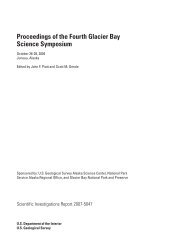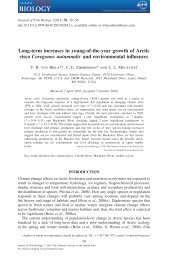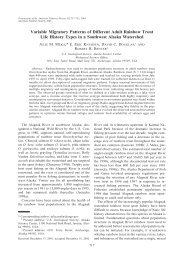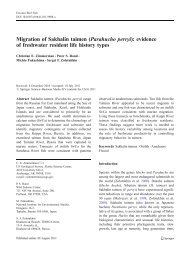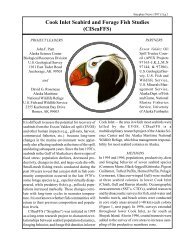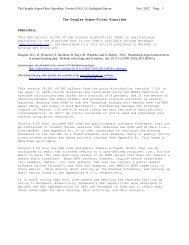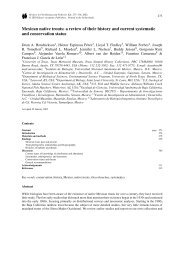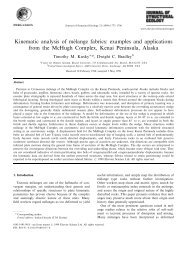Kline, T. C., C. A. Woody, M. A. Bishop, S. P. Powers, and E. E. ...
Kline, T. C., C. A. Woody, M. A. Bishop, S. P. Powers, and E. E. ...
Kline, T. C., C. A. Woody, M. A. Bishop, S. P. Powers, and E. E. ...
You also want an ePaper? Increase the reach of your titles
YUMPU automatically turns print PDFs into web optimized ePapers that Google loves.
ASSESSMENT OF MARINE-DERIVED NUTRIENTS IN THE COPPER RIVER DELTA<br />
salmon may be released prior to decomposition<br />
as excrement <strong>and</strong> gametes (Mathisen et<br />
al. 1988). The RP has been shown to be<br />
important for pelagic systems such as sockeye<br />
salmon nursery lakes (<strong>Kline</strong> et al. 1993) while<br />
the DP may be more important in stream systems<br />
(Bilby et al. 1996). The RP <strong>and</strong> DP generated<br />
different expected stable isotope values<br />
in biota because, whereas C <strong>and</strong> N remain<br />
coupled when marine organic N was consumed,<br />
they were decoupled during decomposition<br />
(<strong>Kline</strong> et al. 1993). We expected a<br />
similar result for S. Because N is enriched by<br />
trophic process, the DP results in δ15N values<br />
of consumers greater than that of the marine<br />
source. Because S <strong>and</strong> C isotopes values are<br />
more conservative in food chains, the expected<br />
δ34S <strong>and</strong> δ13C’ values in a DP food<br />
web would be approximately the same as<br />
adult salmon. In all cases isotope values<br />
were expected to be positively correlated to<br />
MDN, MDS, <strong>and</strong> MDC, <strong>and</strong> therefore with<br />
each other.<br />
Marine-derived nutrients are hypothesized<br />
to be an integral component of biological<br />
productivity in salmon watersheds; this<br />
study was done to further establish where,<br />
when <strong>and</strong> how both marine- <strong>and</strong> watershedderived<br />
nutrients should be monitored using<br />
stable isotopes.<br />
Study Area<br />
SIA was used to trace mdn in the Copper<br />
River delta (CRD). The CRD is a coastal plain<br />
measuring ~50 km east–west by ~20 km<br />
north–south in size bounded by the Chugach<br />
Mountains to the north <strong>and</strong> the Gulf of Alaska<br />
to the south. Eyak Lake <strong>and</strong> the Heney<br />
Range, which are adjacent to Cordova, Alaska,<br />
form the western boundary, whereas Ragged<br />
Mountain, immediately east of the Copper<br />
River, forms the eastern boundary. The CRD<br />
watershed includes the Copper River, with a<br />
watershed that bounds the Alaska Range to<br />
the north, <strong>and</strong> numerous smaller rivers <strong>and</strong><br />
lakes draining from the Chugach Mountains<br />
including Eyak <strong>and</strong> McKinley Lakes. Sampling<br />
for SIA focused on two CRD systems,<br />
the McKinley-Alaganik system, which is<br />
located immediately west of the Copper River,<br />
<strong>and</strong> the Eyak system that forms the western<br />
portion of the CRD (Table 1). Annual precipitation<br />
in Eyak <strong>and</strong> McKinley Lakes is<br />
about 4.5 m <strong>and</strong> 3.5 m, <strong>and</strong> ice cover lasts<br />
3–7 <strong>and</strong> 5–7 months, respectively (corrected<br />
metric conversion from Pellissier <strong>and</strong> Somerville<br />
1987). Alaganik Slough drains the westernmost<br />
branch of the Copper River <strong>and</strong><br />
McKinley Lake (surface area = 114 ha, maximum<br />
depth = 11 m, mean depth = 5.1<br />
m; Pellissier <strong>and</strong> Somerville 1987). Power<br />
Creek, which is glacial, is the principal<br />
salmon spawning tributary of Eyak Lake (surface<br />
area = 1,000 ha, maximum depth = 7<br />
m, mean depth = 1.7 m; Pellissier <strong>and</strong><br />
Somerville 1987).<br />
Salmon species of interest are sockeye<br />
Oncorhynchus nerka <strong>and</strong> coho O. kisutch that<br />
spawn <strong>and</strong> rear in the CRD prior to smolting.<br />
Maturing sockeye salmon enter CRD freshwaters<br />
in late May <strong>and</strong> spawn from July to October,<br />
at which time coho salmon arrive <strong>and</strong><br />
spawn until December. A small number<br />
(~500) of pink salmon O. gorbuscha also<br />
spawn in the Eyak system compared to about<br />
10,000 sockeye <strong>and</strong> 7,500 coho salmon (Pellissier<br />
<strong>and</strong> Somerville 1987). Approximately<br />
7,000 sockeye <strong>and</strong> 1,500 coho salmon spawn<br />
within the McKinley watershed (Pellissier <strong>and</strong><br />
Somerville 1987). A small but unspecified<br />
number of coho salmon also spawn in Alaganik<br />
Slough. What may also be significant<br />
are occasional large (thous<strong>and</strong>s of individuals),<br />
but poorly documented, runs of anadromous<br />
<strong>and</strong> semelparous eulachon Thaleichthys<br />
pacificus that arrive <strong>and</strong> spawn in Alaganik<br />
Slough <strong>and</strong> Eyak River during late winter to<br />
early spring providing an additional marine<br />
nutrient source.<br />
53




